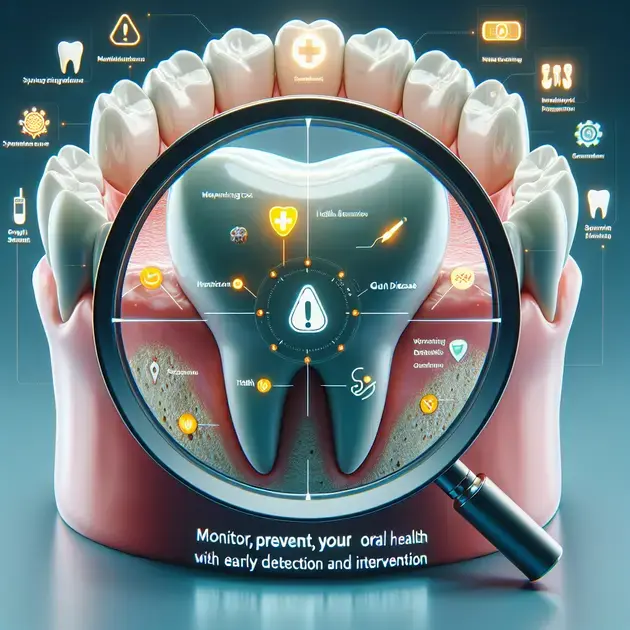Are you experiencing bleeding gums or persistent bad breath? These could be signs that you might have gum disease. In this guide, we will explore the common symptoms and risk factors associated with this oral health condition.
Gum disease, also known as periodontal disease, affects a large percentage of the population worldwide. According to recent studies, over 47% of adults aged 30 years and older suffer from some form of gum disease. Understanding the signs and taking early preventative measures can help maintain optimal oral health.

Common Symptoms of Gum Disease
When it comes to gum disease, there are several common symptoms to look out for. One of the most noticeable signs is bleeding gums, especially when brushing or flossing. Additionally, you may experience swollen or tender gums, persistent bad breath, receding gums, and loose teeth. If you notice any of these symptoms, it’s important to see a dentist for a proper diagnosis.
To check for symptoms of gum disease, you can use the app “Dental Care – Symptoms Checker.” This app allows you to input your symptoms and receive information on potential conditions, including gum disease. It provides detailed descriptions of each symptom and offers guidance on when to seek professional help.
Monitoring your gum health is crucial in preventing the progression of gum disease. Regular dental check-ups and cleanings can help detect early signs of gum disease and prevent further complications. Remember to maintain a good oral hygiene routine, including brushing twice a day, flossing, and using an antiseptic mouthwash.
If you suspect you have gum disease based on the symptoms you’re experiencing, it’s essential to schedule an appointment with your dentist promptly. Early detection and intervention are key to preventing the disease from advancing and causing irreversible damage to your gums and teeth.
By staying vigilant and aware of the common symptoms of gum disease, you can take proactive measures to maintain optimal oral health and prevent more severe issues down the line.
Risk Factors to Consider
When assessing your risk for developing gum disease, there are several factors to consider. Some common risk factors include poor oral hygiene, smoking, diabetes, hormonal changes in women, genetic predisposition, and certain medications that reduce saliva flow. Understanding these risk factors can help you take proactive steps to prevent gum disease.
To evaluate your risk factors for gum disease, you can use the website “Oral Health Risk Assessment Tool.” This online tool guides you through a series of questions related to your oral health practices, lifestyle habits, and medical history to assess your risk level for gum disease. It provides personalized recommendations based on your individual risk factors.
It’s essential to address and manage the risk factors within your control to reduce the likelihood of developing gum disease. This may involve quitting smoking, improving your oral hygiene routine, managing underlying health conditions like diabetes, and discussing the potential side effects of medications with your healthcare provider.
Regular consultations with your dentist can also help identify specific risk factors that may predispose you to gum disease. By staying informed and proactive in managing these risks, you can significantly lower your chances of experiencing gum disease and its associated complications.
Remember that prevention is key when it comes to gum disease, and being aware of your risk factors is the first step towards maintaining optimal oral health.
Preventative Measures for Optimal Oral Health
To ensure optimal oral health and reduce your risk of gum disease, there are various preventative measures you can incorporate into your daily routine. Firstly, maintaining a consistent oral hygiene regimen is crucial, including brushing your teeth twice a day with fluoride toothpaste and flossing regularly to remove plaque buildup.
Using the app “Oral Care Tracker,” you can set reminders for your brushing and flossing routine, track your daily oral hygiene activities, and receive tips on proper oral care techniques. This app can help you stay accountable and ensure that you’re taking the necessary steps to prevent gum disease.
In addition to good oral hygiene practices, maintaining a healthy diet rich in fruits, vegetables, and lean proteins can support overall oral health. Limiting sugary and acidic foods and drinks can also help protect your teeth and gums from decay and disease.
Regular dental check-ups are vital for early detection of any oral health issues, including gum disease. Your dentist can perform a thorough examination, clean your teeth, and provide personalized recommendations for preventing gum disease based on your specific needs.
By incorporating these preventative measures into your daily routine and staying proactive about your oral health, you can effectively reduce your risk of developing gum disease and enjoy a healthy, vibrant smile for years to come.

**Early Warning Signs of Gum Disease**
Recognizing the Early Signs
Early warning signs of gum disease can be easy to overlook, but it is crucial to be vigilant about any changes in your oral health. One of the first signs of gum disease is bleeding gums, especially when brushing or flossing. Additionally, gums that appear red, swollen, or tender may indicate the presence of gingivitis, the initial stage of gum disease.
Regular Dental Check-ups
It is essential to visit your dentist regularly to detect any early warning signs of gum disease. During these check-ups, your dentist can evaluate the health of your gums and provide professional cleanings to remove plaque and tartar buildup.
Proper Oral Hygiene Practices
Practicing good oral hygiene at home is key to preventing gum disease. Brushing your teeth twice a day, flossing daily, and using an antiseptic mouthwash can help keep your gums healthy and reduce the risk of developing gum disease.
Healthy Lifestyle Habits
Factors such as smoking, poor nutrition, and certain medications can contribute to the development of gum disease. By maintaining a healthy lifestyle, including a balanced diet and avoiding tobacco products, you can lower your risk of gum disease.
Early Intervention
If you notice any of these early warning signs of gum disease, it is important to seek treatment promptly. Early intervention can help prevent the progression of gum disease and protect your oral health in the long run.
Preventing Progression
Once gum disease progresses beyond the initial stage of gingivitis, it can lead to more severe conditions such as periodontitis. Understanding the stages of periodontal disease is essential for preventing its progression and maintaining healthy gums.
Stage 1: Gingivitis
In the early stage of gum disease, known as gingivitis, the gums become inflamed due to plaque buildup. Common symptoms include bleeding gums, bad breath, and gum sensitivity. With proper oral hygiene and professional cleanings, gingivitis is reversible.
Stage 2: Early Periodontitis
If gingivitis is left untreated, it can progress to early periodontitis, where the infection affects the supporting structures of the teeth. This stage may involve gum recession, pockets forming between the gums and teeth, and early signs of bone loss.
Stage 3: Moderate Periodontitis
As periodontitis advances, it can reach the moderate stage, characterized by deeper pockets around the teeth and increased bone loss. At this point, the damage to the gums and bone may become irreversible, requiring more extensive treatment to prevent tooth loss.
Stage 4: Advanced Periodontitis
In the most severe stage of periodontal disease, advanced periodontitis, there is significant destruction of the gums, bone, and supporting structures of the teeth. Tooth mobility, abscess formation, and eventual tooth loss are common outcomes without prompt and aggressive periodontal therapy.
Understanding Genetic Influences
Research has shown that genetics can play a role in determining an individual’s susceptibility to gum disease. Understanding how genetics can impact gum health is essential for personalized dental care and disease prevention.
Genetic Predisposition
Some individuals may have inherited genetic factors that make them more prone to developing gum disease. These genetic predispositions can affect the immune response, inflammation levels, and healing processes in the gums, influencing the progression of periodontal disease.
Family History
Individuals with a family history of gum disease are at a higher risk of developing similar oral health conditions. Sharing information about your family’s dental history with your dentist can help in early detection and proactive management of gum disease.
Personalized Treatment Approach
By considering the genetic influences on gum health, dental professionals can tailor treatment plans to address individual risk factors and provide targeted care. Genetic testing and screening may also be used to identify specific vulnerabilities and implement preventive measures accordingly.
Lifestyle Modifications
While genetics can contribute to the likelihood of developing gum disease, lifestyle factors such as oral hygiene practices, diet, and tobacco use still play a significant role in overall gum health. Combining genetic insights with healthy habits can optimize oral health outcomes and minimize the impact of genetic predispositions.
Conclusion
In conclusion, early detection and proactive management are essential in preventing the progression of gum disease. Recognizing the early warning signs such as bleeding gums, inflammation, and tenderness is crucial for timely intervention. Regular dental check-ups play a vital role in maintaining optimal gum health by allowing for professional evaluations and cleanings to remove plaque buildup.
Furthermore
Proper oral hygiene practices, including regular brushing, flossing, and the use of mouthwash, are key factors in preventing gum disease. Adopting healthy lifestyle habits such as avoiding smoking, maintaining a balanced diet, and staying informed about genetic influences can significantly reduce the risk of developing periodontal conditions.
Lastly
Understanding the different stages of gum disease, from gingivitis to advanced periodontitis, underscores the importance of early intervention. By combining genetic insights with lifestyle modifications and personalized treatment approaches, individuals can optimize their oral health outcomes and minimize the impact of genetic predispositions on gum disease development.
